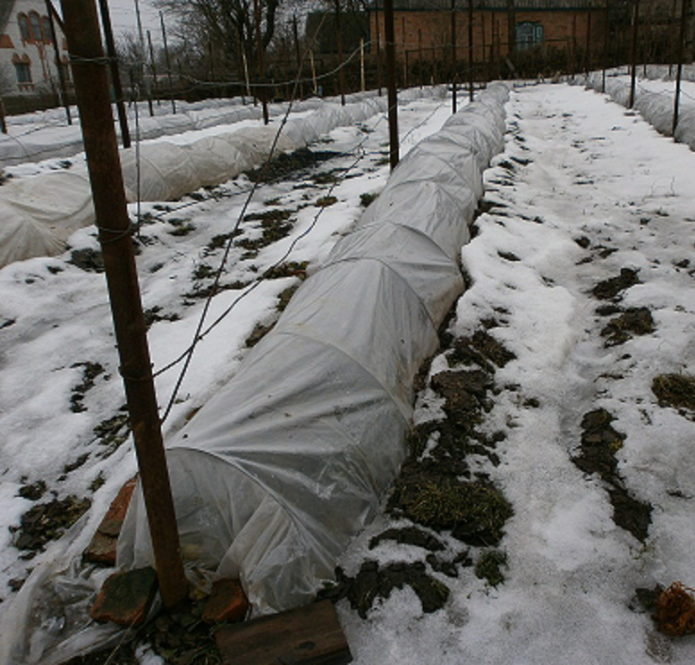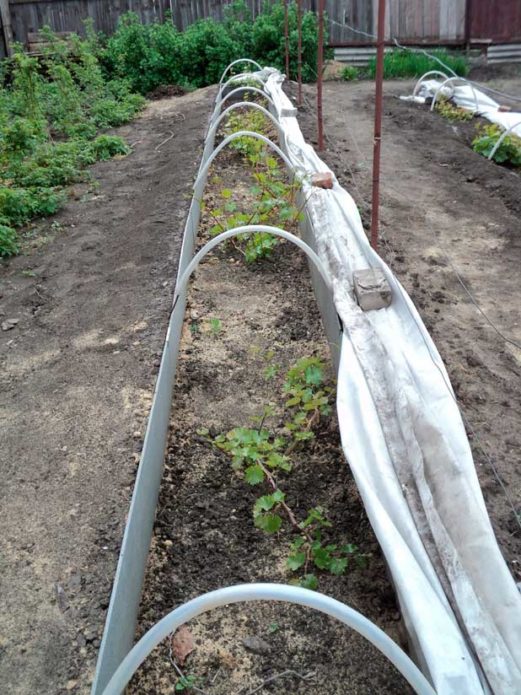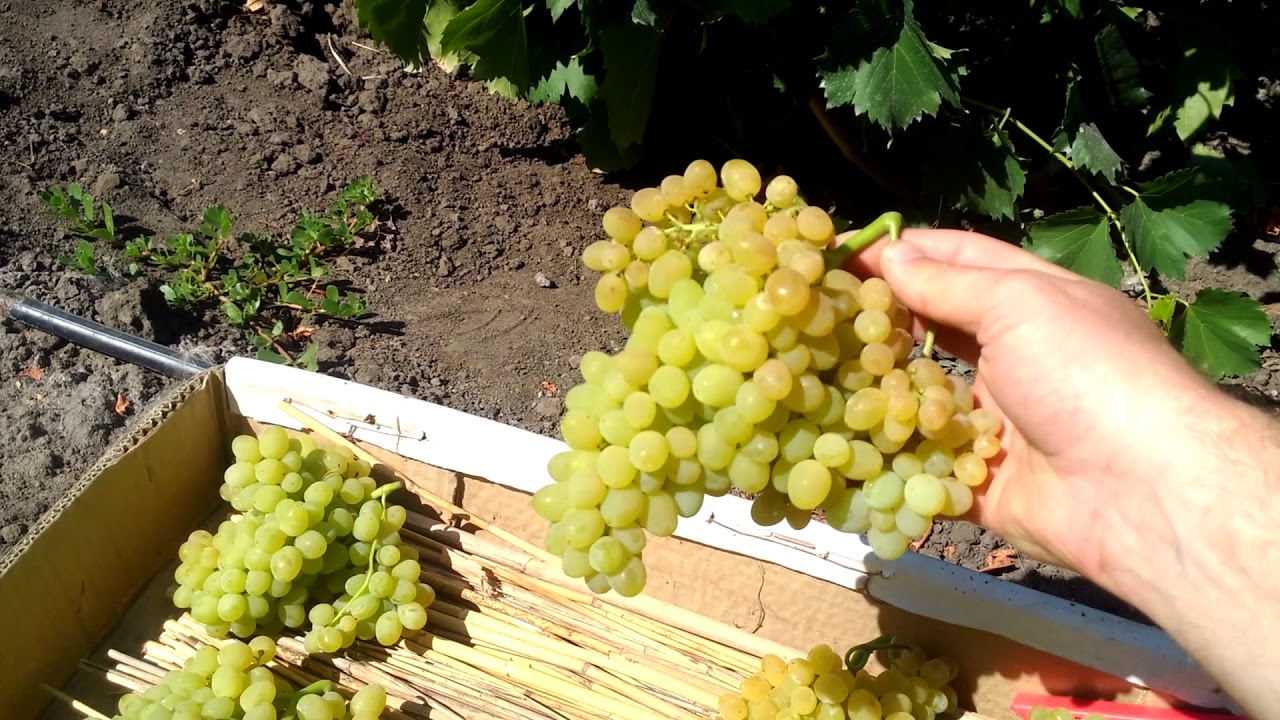Grape care in the new season begins with the correct extraction of the vine from under the winter shelter. When breeding crops in cool temperatures and frosty winters, this is an integral ritual of the gardener. The opening of grapes is carried out taking into account the climatic indicators of the growing region. So, where to start, how to avoid mistakes, in what sequence to open grapes when using a specific shelter option.
Content
The main criteria for removing the winter shelter from the vine
The main factors influencing the start of open-pit works are the following conditions:
- Complete melting of the snow cover on the site.
- The soil absorbed the bulk of the flood and the topsoil dried up (puddles and the feeling of waterlogging disappeared).
- The average daily temperature is not lower than -5 ° C.
Let's consider each factor separately. Snow cover during melting provokes spring floods. The land, depending on the composition, either copes with water abundance, or not. Drainage grooves dug in the fall, which drain excess water from the vines, will help. Waterlogging is dangerous for diseases of the root system and fungal infections of the aboveground and underground parts of the plant.
Drying out the top layer of the earth allows you not to be afraid of the possibility of freezing of the culture in the ice in the event of recurrent frosts. The overwintered grape bush can withstand a drop in ambient temperature to -5 ° C in the absence of excess moisture in the upper layer of the earth. But don't overestimate the plant's health.
After removing the "winter coat", a little support in the form of a film cover on cold days and nights (with opening in sunny weather) helps the grapes to start growing and developing in time in the new growing season. It is undesirable to both overexpose the plantings under insulation, and prematurely open them before the snow cover completely disappears. Both extremes can lead to the loss of both the crop and its carrier. The awakening of the buds under cover will result in the death of young shoots under the sun's rays.
Experienced gardeners are always ready for the return of frosty weather when the vineyard has already been freed from winter shelter. In this case, they have in store straw mats or at least agrofibre, hay and last year's foliage. If there is a threat of recurrent frosts, a temporary shelter for the bushes should be built.
Permissible regional opening times for grapes
The disclosure of grapes in a particular region depends on several strong points. Among them, an important role is played by:
- climate features;
- the duration of the period of return frosts.
For awake kidneys, even short-term drops in temperature (night frosts) cause irreparable damage. The surviving specimens will either give empty shoots or yield a weak harvest.
Experienced growers in the timing of removing the covering material from the culture listen to their own intuition and are guided by the experience gained. For beginners, a guide to action will be the advice and recommendations of "experienced comrades."
Video: removing a shelter from grapes
Moscow region, Central Russia and the Volga region
The opening of a vineyard in regions close to the climatic indicators of the Middle zone depends on the temperature regime and the intensity of precipitation in the spring. With an energetic, early spring, you can remove the mount from mid-April. A late, prolonged and damp spring will push the dates back to early May.
Ukraine, South of Russia
The warm climate dictates its own conditions for the start of the new season. The danger of recurrent frosts usually goes away by the end of March. The term for extracting the vines from under the shelter is from the 20th of the first spring month to the last days of April. The most suitable days are selected based on the main characteristics of spring.
Ural, Siberia, North of Russia and the Far East
The end of wintering in areas with a cold climate is often delayed until mid-spring. It is not worth rushing to release the plantings from insulation in local conditions. As a safety net, a greenhouse structure is placed over the grapes opened in early May.
This will help protect the hatching buds and young shoots from possible spring frosts. With a steady night temperature of +5 ° C, shelters are used with probable drops beyond the zero mark.
Grape opening technology after winter
For the winter, grapes are covered in three common ways:
- burying with earth (the vine is laid on the ground and covered with a layer of soil);
- partial shelter (plant roots spud or wrap the trunk and sleeves in a kind of "shirt");
- complete shelter (branches are laid on a base of boards, slate, plywood, covered with reeds, straw, burlap on top, wrapping the entire structure with film).
The stages of removing the insulation directly depend on the chosen shelter option.
Root hilling (dropping)
It is used on young plants and in warm climates (Ukraine, South of Russia). Liberation from such "captivity" is easy to execute. With neat, light movements, the grape bush is freed from the earthen embankment, the branches are gradually raised to their location on the backwaters. It is advisable to act for greater safety of the vine before the onset of complete drying of the soil.
Damp earth is easier to shake off the lashes without causing severe damage. Dry soil provokes brittle branches and cracking of the bark. Along with this, the costs of efforts increase by preliminary digging in the soil around the bush. Only after that they begin to extract the grape branches from the ground.
Semi-shelter (partial)
Suitable for wintering grapes in the Moscow region, Central Russia and the Volga region. The covering material is removed gradually:
- The upper branches (sleeves) open first.
- After two to three days, the remaining aerial part is released.
- Around the bush, a film or covering material is laid on the soil (to warm the earth around the roots and restore the nutrition of the kidneys).
Experienced gardeners are advised to first make ventilation holes in the covering material. When the buds begin to sprout, it's time to remove the cover.
Full cover of the vine
A variant used for wintering grapes in the Urals, Siberia, the North of Russia and the Far East. It is successfully used in the Middle Lane, along with the semi-covering method. The opening of grapes from under such insulation is carried out in several stages:
- The top layer of the shelter is removed (film coating, roofing material).
- After two to three days, the vine is freed from internal insulation (straw, spruce branches).
- A frame is installed over a vine ridge, covered with a film, polycarbonate or non-woven material (for gradual accustoming to the sun's rays, preventing the influence of recurrent frosts on the vine).
A spring greenhouse requires regular ventilation. In regions with a harsh climate, additional soil heating is used. Next to the roots of each bush, a pipe is dug in to a half-meter depth. At stable night temperatures, not falling below +5 ° C, pipe irrigation with warm water (+25 ° C) is performed. This hydration helps the buds to awaken quickly with adequate root nutrition.
To avoid sunburn of the kidneys, the winter shelter should be removed in cloudy weather or in the evening.
The timing of the removal of the winter shelter is tied to the characteristic features of the coming spring. Early or lingering, warm, dry or rainy, and cold. It is important to remember: unsteady temperature conditions and spring frosts can negate the effort expended in growing grapes. The climatic conditions of the growing regions also contribute.





